Plan your Nanjing Tour? One of the highlights in Nanjing is Dr. Sun Yat-sen’s Mausoleum, which is located on the north slope in the Zhongshan Mountain Scenic Spot (钟山风景名胜区).
Zhongshan Mountain Scenic Spot
Zhongshan Mountain Scenic Spot is named after the same name mountain known as “Zhongshan Mountain”, which is also nicknamed “Zijin Mountai ( or Purple Mountain). It is situated in the east of Nanjing, now an AAAAA scenic area by the China National Tourism Administration.
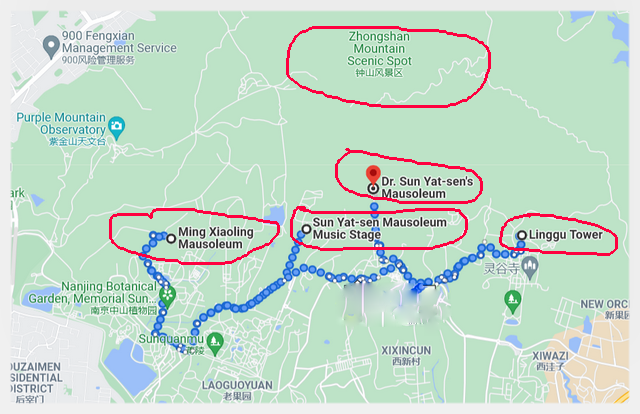
Dr. Sun Yat-sen’s Mausoleum as its its biggest draw, the Zhongshan Mountain Scenic Spot boasts numerous attractions including the four highlights – Ming Xiaoling Mausoleum, Dr.Sun Yatsen’s Mausolseum, Sun Yat-sen Mausoleum Music Stage and Linggu Temple Scenic Area.
Entrance Fees
Dr.Sun Yatsen’s Mausoleum: free of charge
Ming Xiaoling Mausoleum: 70 yuan ( World Heritage)
Sun Yat-sen Mausoleum Music Stage: 10 yuan
Linggu Temple Scenic Area: 35 yuan
How to get to Zhongshan Mountain National Park
Public Bus: take sightseeing bus Line 4 and get off at East Zhongshan Bus Stop, then walk about 791 meters to get to Dr.Sun Yatsen’s Mausoleum, the heart of the park.
In the huge scenic area, there are free shuttle small trains going between the Mausoleum of Sun Yat-sen and the Mausoleum of Ming Xiaoling, and you can use your entrance ticket for free ride.
Taking the subway line 2 and get off at the station of Ming Xialing Tomb (Muxu) Station 明孝陵(苜蓿)站, then you can walk to the site of Dr. Sun Yat-sen Mausoleum or you take an electric car from the station of Ming Xialing Tomb (Muxu) Station to Dr. Sun Yat-sen Mausoleum (RMB 5 per person).
How to Visit Dr. Sun Yat-sen’s Mausoleum
Dr. Sun Yat-sen is considered to be the “Father of Modern China” who fought against the imperial Qing government and ended the monarchy and established the Republic of China after the 1911 revolution. He died on March 12, 1925 in Beijing. His coffin was temporarily placed inside a pagoda in Bingyun Temple of Fragrant Hill in Beijing before being moved to Nanjing for burial on June 01, 1929.
The construction of the mausoleum started in January, 1926 and was finished in the spring of 1929. Its architect was Lu Yanzhi. The massive mausoleum blends the styles of traditional imperial tombs and modern architecture.
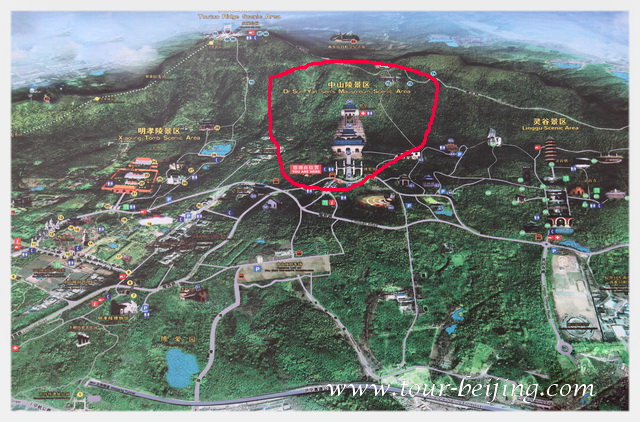
The sacrificial hall (Marble sarcophagus) is 700m away with a drop of 70m from the starting point below – the Paifang, a traditional Chinese architectural gate style as an arch, also the entrance of the mausoleum. The Paifang (arch) is carved with two Chinese characters “Bo Ai” meaning “Universal Love” written by Dr. Sun Yat-sen.
The stairway from Paifang to the Sacrificial Hall has 392 stairs leading up to the main hall guided by pine, cypress, and ginkgo trees on both sides. A few stairs behind the Paifang is a gate, 16 meters high and 27 meters wide. The marble gate is inscribed with four Chinese characters written by Dr. Sun, “Tian Xia Wei Gong” meaning “All under heaven is for all”.
Behind the marble gate is the pavilion which houses a 9-meter-high stele, a memorial monument set by the Kuomintang (KMT). Walk up for quite a few steps you will reach the Sacrificial Hall, a palace of 30 meters long, 25 meters wide and 29 meters high.
In the center sits a statue of Dr. Sun Yat-sen, sculptured out of Italian white marble. The flag of the Kuomintang clings to the ceiling of the hall. Inside hall, you will see biographical information on Dr. Sun Yat-sen. Behind his statue lies the sarcophagus of Dr. Sun.
Opening Hours: 8:30-17:00 (Monday closed)
Entrance Fee: Free of Charge
How to get to Dr. Sun Yat-sen’s Mausoleum
Taking the subway line 2 and get off at the station of Ming Xialing Tomb (Muxu) Station 明孝陵(苜蓿)站, then you can walk to the site of Dr. Sun Yat-sen Mausoleum or you take an electric car from the station of Ming Xialing Tomb (Muxu) Station to Dr. Sun Yat-sen Mausoleum (RMB 5 per person).
Virtual Tour of Dr. Sun Yat-sen’s Mausoleum
Follow us to have a virtual tour of Dr. Sun Yat-sen’s Mausoleum.
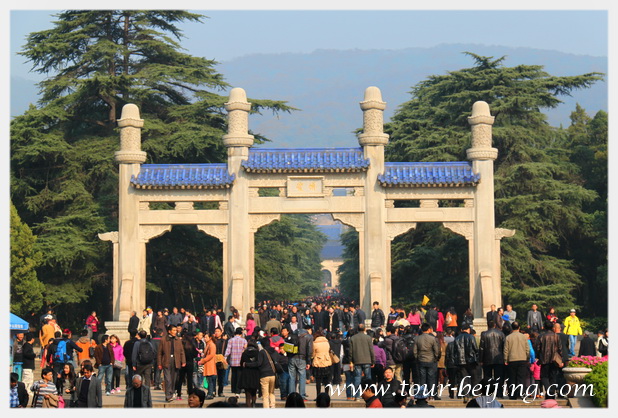
It is a 700 m walk with 392 steps from the Paifeng up to the sacrificial hall (Marble sarcophagus) with a drop of 70m. The stair way up is flanked by pine, cypress, and ginkgo trees on both sides.
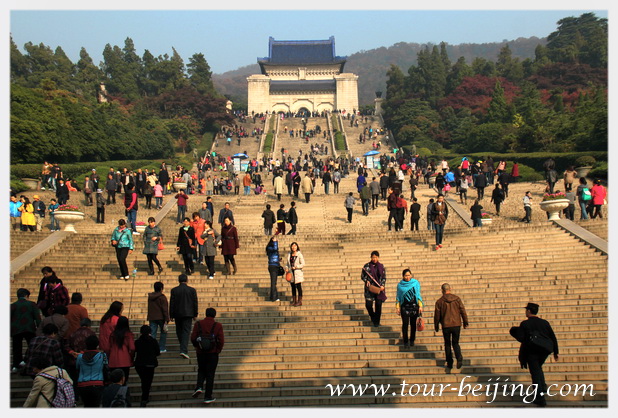
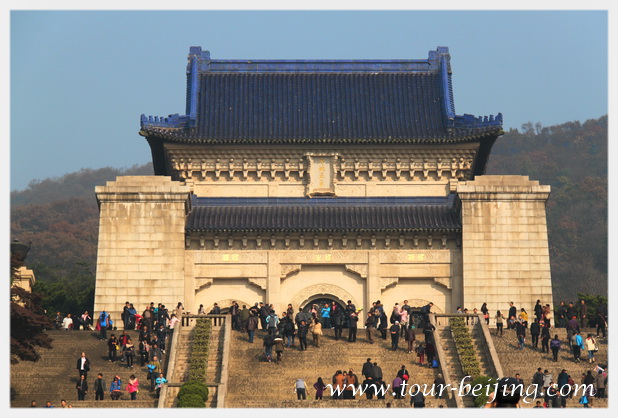
In the center sits a statue of Dr. Sun Yat-sen. Behind his statue lies the sarcophagus of Dr. Sun. Photography is forbidden inside the hall. The photo is from Internet.
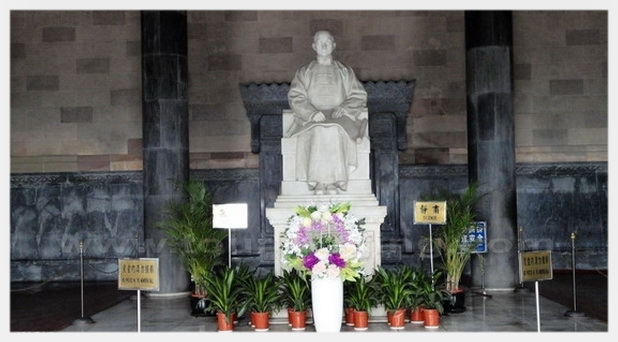
Tip: Hassle-free Jiangsu Guided Tours
If you don’t want to do a self-guided tour and prefer the hassle-free escorted tours, here are some options for organized tours to Jiangsu Province:
Nanjing Tour
Suzhou Tour
Jiangsu Tour
Further Readings
Top 10 Attractions in Nanjing
How to Visit Nanjing Massacre Memorial Hall
How to Visit Nanjing Confucius Temple-The Qinhuai River Scenic Area
How to Visit Zhonghua Gate Nanjing
How to Visit Nanjing Yangtze River Bridge
How to Visit Linggu Temple Scenic Area
Sun Yat-sen Mausoleum Music Stage
How to Visit Dr. Sun Yat-sen’s Mausoleum
How to Visit Ming Xiaoling Mausoleum
How to Visit Nanjing Presidential Palace
Nanjing South Railway Station
Nanjing Taxi: Nanjing Taxi Fares, Tips and Phones
Suzhou Railway Station
Suzhou Taxi: Suzhou Taxi Fares, Tips and Phones
Top 10 Attractions in Suzhou
Suzhou Railway Station
How to Visit Tongli Water Town
How to Visit Zhouzhuang Water Town
How to Visit Pingjiang Road in Suzhou
How to Visit The Garden of the Master of the Nets
How to visit Humble Administrator’s Garden
How to Visit Lion Grove Garden
How to Visit Canglang Pavilion
How to Visit Guanqian Street in Suzhou
4 Amazing Short Trip Ideas from Shanghai
Wuzhen Pictures – Wuzhen Photo Gallery
Zhouzhuang Pictures – Zhouzhuang Photo Gallery
Any questions, just drop a line.





